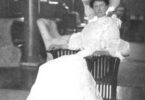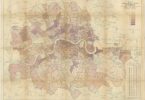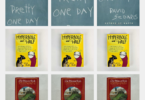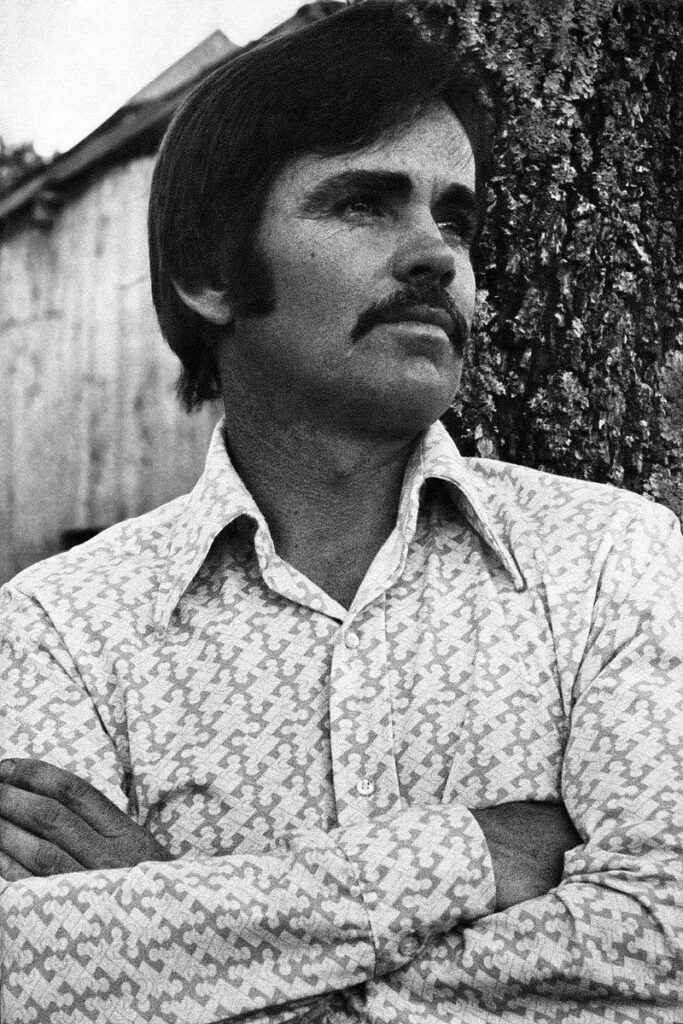
Author Cormac McCarthy was born Charles Joseph McCarthy Jr, on July 20th, 1933, in Providence, Rhode Island, and raised primarily in Knoxville, Tennessee. He is widely regarded as one of the greatest American authors of his time.
McCarthy was the eldest of six children in an Irish-Catholic family. His father was a prominent lawyer with the Tennessee Valley Authority, allowing the family to grow up comfortably upper-middle class. The young McCarthy chose to go by Cormac, which is Gaelic for “son of Charles,” rather than his given name, Charles, to avoid confusion with Charlie McCarthy, the ventriloquist dummy.
In 1951 he enrolled in the University of Tennessee but quit to join the Air Force in 1953. While stationed in Alaska in the Air Force, he began reading books voraciously. When he returned to the University of Tennessee in 1957, he published his first stories, “A Drowning Incident” and “Wake for Susan,” in the student literary magazine, The Phoenix, writing under the name C. J. McCarthy, Jr.. He then dropped out of University again and moved to Chicago, where he began writing his first novel, The Orchard Keeper, while working part-time as an auto mechanic. In 1961 he married Lee Holleman, and they had a child, Cullen, in 1962. Focused on completing his novel, McCarthy asked Holleman to get a part-time job in addition to raising their child and keeping house. They divorced shortly after.
After finishing the manuscript for The Orchard Keeper, McCarthy sent it off to Random House because it was the only publisher he had heard of. There, Albert Erskine, who edited Faulkner and Ralph Ellison, recognized his talent, and the two began a partnership that lasted for 20 years.
Random House published The Orchard Keeper in 1965. Although it didn’t sell well, McCarthy used writing grants awarded based on the book to travel. In 1966 he met his second wife, Anne DeLisle, a singer and dancer aboard an ocean liner. They were married in England in 1966 and settled in Ibiza after traveling. They returned to the states in 1967, settling outside of Knoxville. In 1968 his second novel, Outer Dark, was published, again to low sales. Still, following that publication, he was awarded a Guggenheim fellowship that allowed him to continue writing without outside work.
In 1976 he and his second wife Anne separated. Since that year he has lived mainly in El Paso. For many years he lived in a tiny stone cottage, described as a “hovel,” behind a shopping center. He maintains an office at the Santa Fe Institute, where he is a trustee and functions as an informal writer-in-residence among the highly educated scientists that work there.
Although he had published several books by his late 50s, none of them had sold more than 5,000. He used grants to travel and write, lived in multiple ‘barely-habitable’ houses, and went through two divorces because of his dedication to his craft.
In 1981 he was awarded a MacArthur Scholarship, or ‘genius grant,’ recommended by authors Shelby Foote and Saul Bellow, among others. The $236,000 allowed him to leave Tennessee and travel to the South West to work on his next novel Blood Meridian, which he spent five years writing.
After the publication of Blood Meridian and the retirement of Albert Erskine from Random House, McCarthy changed from Random House to Alfred A. Knopf.
Then, in 1992, his book All the Pretty Horses won the National Book Award and the National Book Critics Circle Award. It also became a bestseller.
Even after the success of his novels, McCarthy lived outside literary circles. For most of his career, he worked without an agent. He never taught at a university or wrote for magazines or newspapers, and he doesn’t give readings or interviews.
McCarthy gave one of his only interviews to Oprah on June 5th, 2007, following her pick of The Road for her book club. The interview took place in the library of the Santa Fe Institute.
In 1998 the 64-year-old McCarthy married his third wife, Jennifer Winkey, who was 32. He had a second son, John, born in 1999.
In addition to his novels, McCarthy wrote a number of plays and screenplay work. In the mid-1970s, McCarthy worked on the screenplay for a PBS film called The Gardener’s Son, which premiered in January 1977. In 1994 Ecco Press published a play McCarthy had written in the 1970s, The Stonemason, which explores three generations of a black family in Kentucky. His 2005 novel No Country for Old Men was first written as a screenplay. McCarthy wrote it quickly, in six months, and it moves along quicker than his earlier novels do. McCarthy published the play The Sunset Limited in 2006, which was turned into a movie by Tommy Lee Jones, starring him and Samuel L. Jackson, in 2011. He wrote the screenplay for Ridley Scott’s 2013 movie The Counselor.
McCarthy also published a nonfiction essay, “The Kekulé Problem,” in the April 20th, 2017 issue of the scientific magazine Nautilus about the unconscious mind and the origin of language.
His novels focus on outcasts and misfits, showing deep and troubling psychology through landscape and dark action. Minimal punctuation and the purposeful absence of semicolons quotation marks are trademarks of McCarthy’s style. Men are the focus of his work, rarely touching the female point of view. There is no romance or domestic issues in his novels.
In the fall of 2022, two new McCarthy novels were released. The Passenger, the first novel in a two-part series about a salvage diver, Bobby Western, in 1980s New Orleans, was released on October 25th, 2022. Stella Maris, the second novel in The Passenger Series, was released on November 22nd, 2022. Stella Maris is from the viewpoint of Bobby’s sister, Alicia, eight years before The Passenger. The female point of view is a new vantage for McCarthy.
In his 1992 New York Times interview McCarthy mentioned he only cares for writers who “deal with issues of life and death.” The passing of Cormac McCarthy on June 13, 2023, marked the end of an era for American literature, leaving behind a profound void in the literary landscape.
The time to begin collecting McCarthy’s works, if you haven’t already, is now. Here’s the list of his published works, first edition points, and current values.
The Orchard Keeper (1965)

The first novel by Cormac McCarthy, Orchard Keeper, was published by Random House in 1965. Set in rural Tennessee between the World Wars, the story involves Arthur Ownby, an old hermit who lives at the edge of an orchard, John Wesley Rattner, a young boy, and Marion Sylder, a bootlegger who has killed Rattner’s father, although both are oblivious to this. The writing of William Faulkner heavily influenced this novel, and it was awarded the 1966 William Faulkner Foundation Award for notable first novel.
The First edition has five reviews of the novel on the back dust jacket, including blurbs by Ralph Ellison, Robert Penn Warren, and James A. Michener. Author photo on the back inside flap and a $4.95 price stamp on the front flap. Stated ‘First Edition’ on the copyright page.
Signed first editions can list for over $15,000, while unsigned firsts for around $5,000 depending on condition.
Outer Dark (1968)
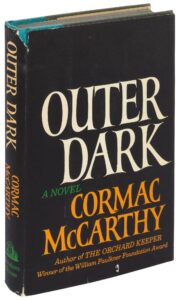
McCarthy’s scarce second novel, Outer Dark, was published by Random House in 1968. The story involves Rinthy Holme, who bears her brother’s child. Her brother, Culla, then takes the baby out to the woods to die, telling his sister the child died of natural causes. She spends the novel looking for the child while her brother tries to outrun his sin. Although published to great critical reviews, it sold poorly – a modest 2,705 copies.
First editions of Outer Dark have$4.95 on the front flap of the dust jacket and ‘First Printing’ stated on the copyright page. The back of the dust jacket has eight reviews from print sources.
First editions list around $3,000, and scarce signed firsts for around $6,000.
Child of God (1973)
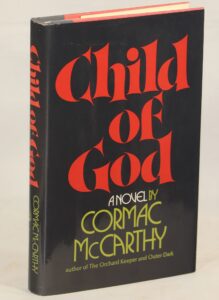
Set in Sevier County, Tennessee, in the 1960s, Child of God tells the story of Lester Ballard, an outcast from society. Released from jail after being falsely accused of rape, Ballard haunts the countryside, falling into deeper and deeper crime and perversion. Considered McCarthy’s darkest work.
First editions of Child of God, published by Random House in 1973, have ‘First Edition’ on the copyright page. The front flap has a price of $5.95, and the back of the dust jacket has a photo of the author and no reviews.
First editions list for around $1,500 and signed firsts for approximately $6,000.
Suttree (1979)
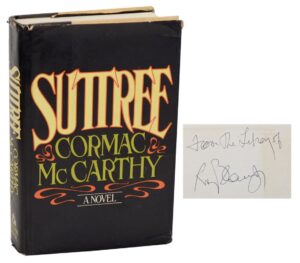
Suttree, the fourth novel by Cormac McCarthy, is considered by some to be his finest. The semi-autobiographical book is set in Knoxville, Tennessee, in the early 1950s and took McCarthy 20 years to write. He was 46 when it was published in 1979. It has been compared to classics like James Joyce’s Ulysses and John Steinbeck’s Cannery Row. Cornelius Suttree has left a well-to-do life, along with a wife and child, to live on the edges of society on the Tennessee River, catching catfish for a living. The novel and his life are dotted with fringe tragic characters in which he searches for his own affirmation.
Random House published the first edition of Suttree in 1979. The front flap has a price of $12.95, and ‘First Edition’ is stated on the copyright page along with a number line of “24689753”. The back of the dust jacket has a full author photo with credit on the bottom left and an ISBN on the bottom right. A signed first can list for over $12,000, and an unsigned first for around $3,000.
Blood Meridian (1985)

McCarthy’s fifth novel, Blood Meridian, or The Evening Redness in the West, is his first classified as a Western. Some consider an epic tale McCarthy’s Magnum Opus and The Great American Novel. The novel follows a teenager known as “the kid” and his experiences with the Glanton Gang, notorious scalp hunters from 1849-1850 in the West, targeting Indigenous Americans along the southern border.
Random House published the first edition of Blood Meridian in 1985. The first edition had a pride stamp of $17.95 on the front flap. The first edition has “First Edition” stated on the copyright page below Random House number line “24689753”. The back of the dust jacket has a photo of the author, with “Photo Credit Mark Morrow” on the bottom left corner and “394-54482-X” on the bottom right corner. First editions list for around $4,000 and above, while signed first editions, incredibly rare, can list for over $40,000.
All the Pretty Horses (1992)
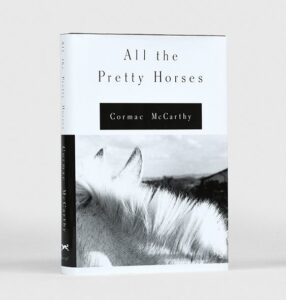
All the Pretty Horses is the first volume in The Border Trilogy. The other two volumes are The Crossing and Cities of the Plain. The novel follows sixteen-year-old John Grady Cole as he sets off to Mexico, hoping to find work as a cowboy after the death of his grandfather. This was the first McCarthy novel published by Alfred A. Knopf, after Albert Erskine, his editor of 20 years, retired from Random House.
All the Pretty Horses was awarded the National Book Award and the National Book Critics Circle Award.
Alfred A. Knopf published the first edition of All the Pretty Horses in 1992. First Edition is stated on the copyright page. The dust jacket carries a $21.00 price on the upper corner of the front flap. There is a variant dust jacket (which is rare) where the text begins with a black letter “A” on the front flap rather than a green “A” which is typically found on most first editions. The variant dust jacket also has four reviews on the back panel rather than the five reviews found on most first editions.
There was also a special advance reading copy that McCarthy signed. This advance copy is a softcover issued in a slipcase.
Signed firsts would list for over $10,000 (very rare), and unsigned firsts in fine condition list around $6,000.
The Crossing (1994)

The second installment of The Border Trilogy, The Crossing, takes place before and during the Second World War and focuses on teenage cowboy Billy Parham and his family, following Parham on a journey to return a she-wolf to her home in the northern Mexican mountains. The novel is noted as more melancholic than All the Pretty Horses, although not as dark as McCarthy’s previous work.
Signed first editions can range from $650 upwards, and unsigned firsts around $100. The retail price was $23.00, and “First Edition” is stated on the copyright page. One thousand copies were issued with a special signed limitation page tipped in for “friends of the author and publisher .”The first printing of The Crossing was 200,000, a large printing for a literary work. By the end of the first month, a second printing was run of 25,000 copies.
Cities of the Plain (1998)
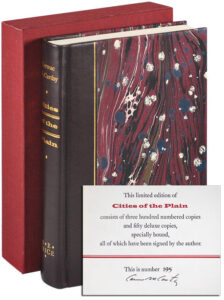
Cities of the Plain, the third novel in The Border Trilogy, brings together John Grady Cole from All the Pretty Horses and Billy Parnham from The Crossing. Cities of the Plain focuses on Parnham’s doomed relationship with a young Mexican prostitute.
The first edition of Cities of the Plain has reviews on the back dust jacket from Kurt Tidmore and Robert Hass. One thousand copies were issued with a special signed limitation page tipped in for “friends of the author and publisher.” The retail price was $24, and “First Edition” is stated on the copyright page.
A limited edition of 300 signed and numbered copies were published at the same time by B.E. Trice Publishing. It has marbled boards with a leather spine and is housed in a cloth slipcase.
No Country for Old Men (2005)
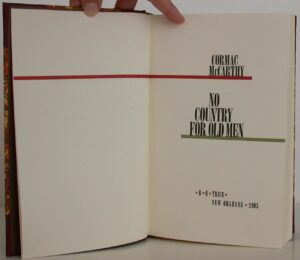
No Country for Old Men is a novel that follows an illegal drug trade on the Mexican border. The title comes from a Yeats poem “Sailing to Byzantium.” Originally written as a screenplay, a film based on the work was released in 2007 to enormous commercial success. It also won numerous awards, including the Oscar for best picture.
The first edition of No Country for Old Men was released by Alfred A. Knopf in 2005. “First edition” is stated on the copyright page, and the retail price was $24.95. First editions list around $1,000 and many have signatures tipped in.
B.E. Trice Publishing in New Orleans published a limited edition of 75 copies in deluxe binding signed by the author in 2005. Another limited edition of 325 signed and numbered copies bound in quarter brown leather with white green, and brown marbled boards and housed in a red slipcase was also released.
The Road (2006)
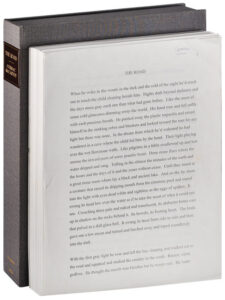
The Road is a post-apocalyptic novel about the journey of a man with his young son. After the destruction of the civilized world and the suicide of the young boy’s mother, the pair leaves their home in the north to seek safety, and hopefully, a safe community of people they believe exists on the Southern Coast. They journey alone through the wilderness, trying to avoid bands of cannibals. The Road won the Pulitzer Prize for Fiction. This book is also an Oprah’s Book Club selection.
Alfred A. Knopf published the first edition of The Road book in 2006. It was 241 pages long, and the dust jacket has a retail price of $24.00 US on the front flap. “First Edition” is stated on the copyright page, and 2006 is stated at the bottom of the title page. The first state dust jacket has a $24.00 price stamp on the front flap, along with 10/2006 on the rear flap. The binding is red (rust) cloth with a black spine. All first editions of The Road have the Borzoi dog blind stamp. The first edition lists for under $500 currently.
References:
“Cormac McCarthy’s Venomous Fiction” from The New York Times, 1992 Interview with Richard B. Woodward
“Cormac Country” from Vanity Fair, 2005 Interview with Richard B. Woodward
Cormac McCarthy Biography from The Official Website of the Cormac McCarthy Society
Amy C. Manikowski is a writer living in Asheville, NC.

